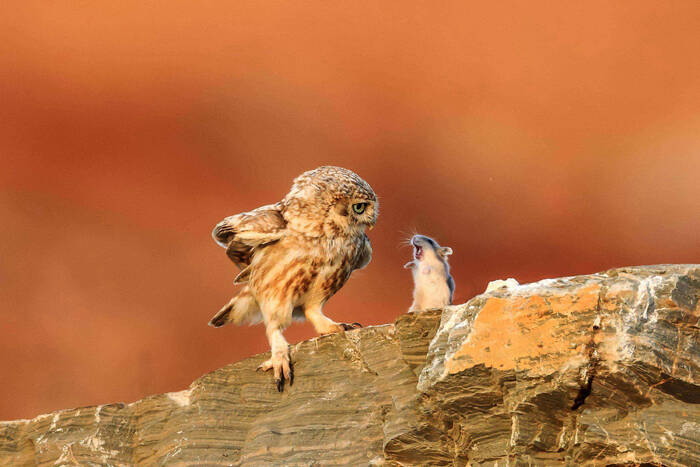Athene noctua (Scopoli, 1769)
IUCN
LCBasic Information
Scientific classification
- name:Athene noctua (Scopoli, 1769)
- Scientific Name:Athene noctua (Scopoli, 1769),little owl,Little Owl, Owl, Owl, Owl Owl
- Outline:Raptor
- Family:Strigiformes Owl
Vital signs
- length:About 23 cm
- Weight:About 140g
- lifetime:5-10years
Feature
The underside is brownish white with brown vertical stripes
Distribution and Habitat
The Little Owl is distributed in Europe, northeastern Africa, western and central Asia, Russia, Iran, Iraq, Afghanistan, Pakistan, northern India, Sikkim, Bhutan, Mongolia and North Korea.
In China, it is distributed in Xinjiang, Sichuan, Tibet, Gansu, Qinghai, Beijing, Hebei, Shanxi, Inner Mongolia, Liaoning, Jilin, Heilongjiang, Jiangsu, Shandong, Henan, Guangxi, Guizhou, Shaanxi, Ningxia and other places.
It lives in low mountains and hills, forest edge shrubs and plain forest areas, and also appears in farmlands, deserts and jungles near villages.
Appearance
There are no ear feathers. The top of the head is flat, and the eyes are bright yellow and long and motionless. The light-colored flat eyebrows and white wide mustache lines make it look ferocious. The upper body is brown with white vertical stripes and spots. The lower body is white with brown spots and vertical stripes, and there are 2 white or leathery yellow horizontal stripes on the shoulders. The iris is bright yellow, the mouth is yellow, the feet are white and feathered, and the claws are dark brown.
Details
The Little Owl with Vertical Stripes is called Little Owl in English. There are 12 (or 14) subspecies, of which 4 are distributed in China.

The Little Owl with Vertical Stripes is a common resident bird, widely distributed in most areas of northern and western China, up to 4,600 meters above sea level. Partially diurnal, often standing on fences and wires, nodding or turning nervously, sometimes standing up on long legs, or flapping wings quickly in waves. It likes to make territorial calls day and night, which are long and rising, with various sounds. It nests in caves or tree holes. It usually comes out at night and when chasing prey, it not only attacks from the air like other birds of prey, but also uses its legs that are good at running to chase. It feeds on insects and rodents, and also eats small animals such as small birds, lizards, and frogs.
The breeding season of the Little Owl is from May to July. The male and female birds increase their calls and activities at dusk and dawn, chasing and playing with each other. The male bird shows off to the female bird by stretching its neck, raising its feathers, and swinging left and right. Usually nests in the cracks of cliffs, caves, caves of abandoned buildings, etc., sometimes in tree holes or caves dug by themselves. Each nest lays 2 to 8 eggs, usually 3 to 5. The eggs are white in color. The female bird is responsible for incubation. The incubation period is 28 to 29 days. The chicks are late-maturing. After hatching, their eyes are closed, they barely raise their heads, lie sideways, and have yellow-white down feathers all over their bodies. They have a large head, a thin neck, and a flesh-blue beak. They need to be fed by their parents for 45 to 50 days before they can fly.
Listed in CITES Appendix: Ⅱ Controlled commercial trade, except for a small amount carried by individuals, all specimens, any export must obtain an export license
Listed as a national key protected wild animal: Level 2. The local competent authorities shall issue domestication and breeding licenses, business licenses, quotas and labels.
Listed in the second level of the "List of National Key Protected Wildlife in China".
Protect wild animals and eliminate game.
Maintaining ecological balance is everyone's responsibility!








